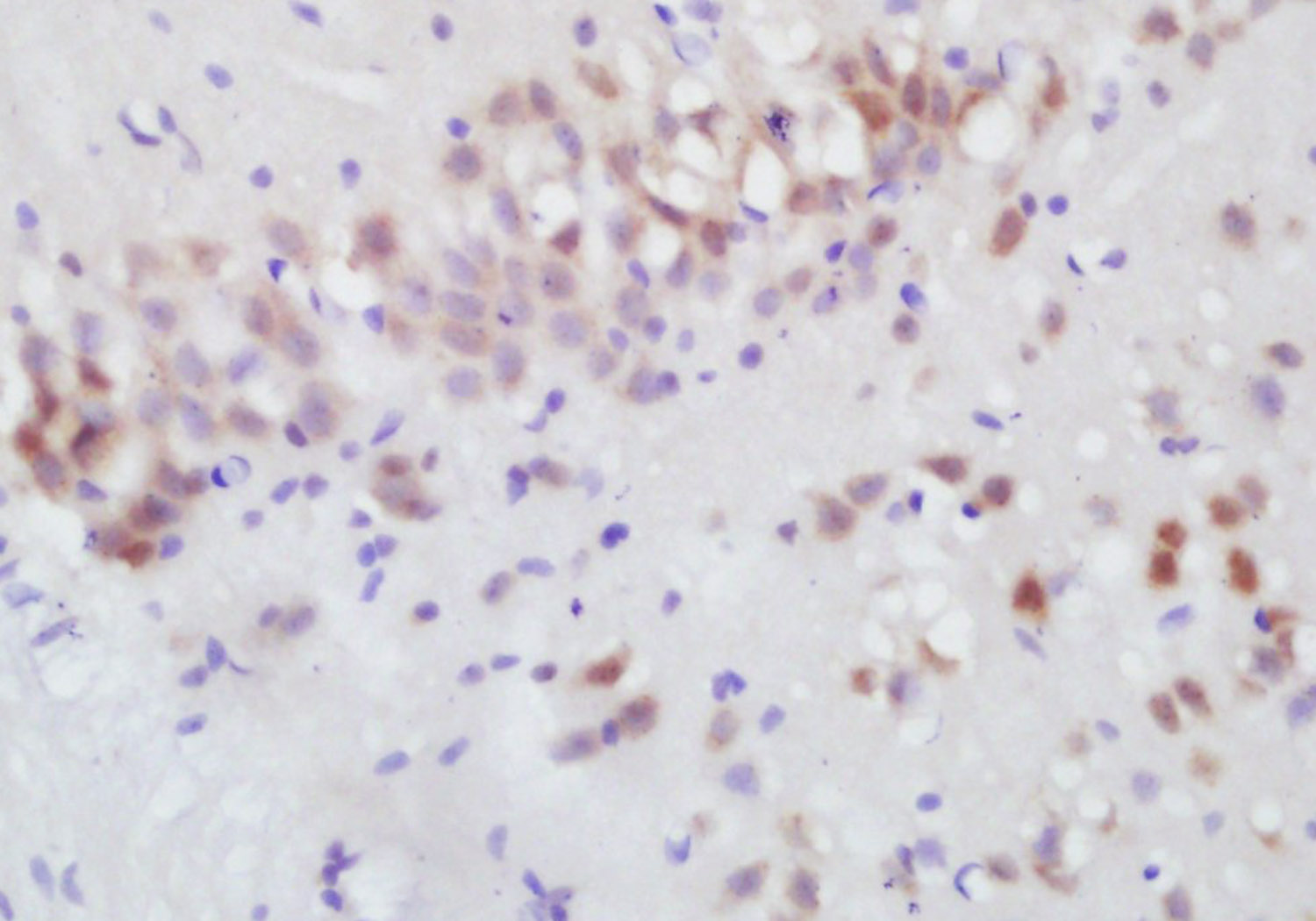DCPS Rabbit pAb
DCPS Rabbit pAb
- 产品详情
- 实验流程
- 背景知识
Application
| IHC-P, IHC-F, IF |
|---|---|
| Primary Accession | Q96C86 |
| Host | Rabbit |
| Clonality | Polyclonal |
| Calculated MW | 38609 Da |
| Physical State | Liquid |
| Immunogen | KLH conjugated synthetic peptide derived from human DCPS |
| Epitope Specificity | 101-200/337 |
| Isotype | IgG |
| Purity | affinity purified by Protein A |
| Buffer | 0.01M TBS (pH7.4) with 1% BSA, 0.02% Proclin300 and 50% Glycerol. |
| SUBCELLULAR LOCATION | Cytoplasm. Nucleus. |
| SIMILARITY | Belongs to the HIT family. |
| SUBUNIT | Homodimer. Associates with components of the exosome multienzyme ribonuclease complex, such as EXOSC3 and EXOSC4. Interacts with NDOR1. |
| Important Note | This product as supplied is intended for research use only, not for use in human, therapeutic or diagnostic applications. |
| Background Descriptions | Eukaryotic cells primarily utilize exoribonucleases and decapping enzymes to degrade their mRNA. DcpS is a scavenger pyrophosphatase that hydrolyzes the residual cap structure following 3' to 5' decay of an mRNA. Following mRNA degradation DcpS releases N-7 methyl guanosine monophosphate and 5'-diphosphate terminated cap or mRNA products. The central histidine within the DcpS HIT motif is critical for decapping activity and defines the HIT motif as a new mRNA decapping domain, making DcpS the first member of the HIT family of proteins with a defined biological function. HIT proteins are homodimeric and contain two conserved 100-amino-acid HIT fold domains with independent active sites that are each sufficient to bind and hydrolyze cognate substrates. |
| Gene ID | 28960 |
|---|---|
| Other Names | m7GpppX diphosphatase, 3.6.1.59, DCS-1, Decapping scavenger enzyme, Hint-related 7meGMP-directed hydrolase, Histidine triad nucleotide-binding protein 5, Histidine triad protein member 5, HINT-5, Scavenger mRNA-decapping enzyme DcpS, DCPS, DCS1, HINT5 |
| Target/Specificity | Detected in liver, brain, kidney, testis and prostate. |
| Dilution | IHC-P=1:100-500,IHC-F=1:100-500,IF=1:100-500 |
| Storage | Store at -20 °C for one year. Avoid repeated freeze/thaw cycles. When reconstituted in sterile pH 7.4 0.01M PBS or diluent of antibody the antibody is stable for at least two weeks at 2-4 °C. |
| Name | DCPS |
|---|---|
| Synonyms | DCS1, HINT5 |
| Function | Decapping scavenger enzyme that catalyzes the cleavage of a residual cap structure following the degradation of mRNAs by the 3'->5' exosome-mediated mRNA decay pathway. Hydrolyzes cap analog structures like 7-methylguanosine nucleoside triphosphate (m7GpppG) with up to 10 nucleotide substrates (small capped oligoribonucleotides) and specifically releases 5'-phosphorylated RNA fragments and 7- methylguanosine monophosphate (m7GMP). Cleaves cap analog structures like tri-methyl guanosine nucleoside triphosphate (m3(2,2,7)GpppG) with very poor efficiency. Does not hydrolyze unmethylated cap analog (GpppG) and shows no decapping activity on intact m7GpppG-capped mRNA molecules longer than 25 nucleotides. Does not hydrolyze 7- methylguanosine diphosphate (m7GDP) to m7GMP (PubMed:22985415). May also play a role in the 5'->3 mRNA decay pathway; m7GDP, the downstream product released by the 5'->3' mRNA mediated decapping activity, may be also converted by DCPS to m7GMP (PubMed:14523240). Binds to m7GpppG and strongly to m7GDP. Plays a role in first intron splicing of pre-mRNAs. Inhibits activation-induced cell death. |
| Cellular Location | Cytoplasm. Nucleus. Note=Predominantly localized in the nucleus. Nucleocytoplasmic shuttling protein that can transiently enter the cytoplasm in mammalian cells in a XPO1/CRM1- dependent manner |
| Tissue Location | Detected in liver, brain, kidney, testis and prostate. |
For Research Use Only. Not For Use In Diagnostic Procedures.
Provided below are standard protocols that you may find useful for product applications.
BACKGROUND
Eukaryotic cells primarily utilize exoribonucleases and decapping enzymes to degrade their mRNA. DcpS is a scavenger pyrophosphatase that hydrolyzes the residual cap structure following 3' to 5' decay of an mRNA. Following mRNA degradation DcpS releases N-7 methyl guanosine monophosphate and 5'-diphosphate terminated cap or mRNA products. The central histidine within the DcpS HIT motif is critical for decapping activity and defines the HIT motif as a new mRNA decapping domain, making DcpS the first member of the HIT family of proteins with a defined biological function. HIT proteins are homodimeric and contain two conserved 100-amino-acid HIT fold domains with independent active sites that are each sufficient to bind and hydrolyze cognate substrates.
终于等到您。ABCEPTA(百远生物)抗体产品。
点击下方“我要评价 ”按钮提交您的反馈信息,您的反馈和评价是我们最宝贵的财富之一,
我们将在1-3个工作日内处理您的反馈信息。
如有疑问,联系:0512-88856768 tech-china@abcepta.com.























 癌症的基本特征包括细胞增殖、血管生成、迁移、凋亡逃避机制和细胞永生等。找到癌症发生过程中这些通路的关键标记物和对应的抗体用于检测至关重要。
癌症的基本特征包括细胞增殖、血管生成、迁移、凋亡逃避机制和细胞永生等。找到癌症发生过程中这些通路的关键标记物和对应的抗体用于检测至关重要。 为您推荐一个泛素化位点预测神器——泛素化分析工具,可以为您的蛋白的泛素化位点作出预测和评分。
为您推荐一个泛素化位点预测神器——泛素化分析工具,可以为您的蛋白的泛素化位点作出预测和评分。 细胞自噬受体图形绘图工具为你的蛋白的细胞受体结合位点作出预测和评分,识别结合到自噬通路中的蛋白是非常重要的,便于让我们理解自噬在正常生理、病理过程中的作用,如发育、细胞分化、神经退化性疾病、压力条件下、感染和癌症。
细胞自噬受体图形绘图工具为你的蛋白的细胞受体结合位点作出预测和评分,识别结合到自噬通路中的蛋白是非常重要的,便于让我们理解自噬在正常生理、病理过程中的作用,如发育、细胞分化、神经退化性疾病、压力条件下、感染和癌症。






